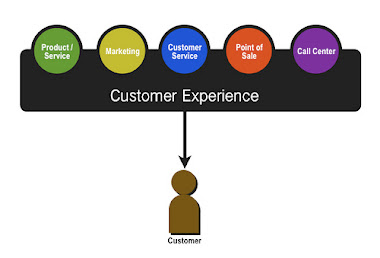Customer Experience Lifecycle
In a previous post,
I mentioned that you need to outline the customer experience lifecycle -
from Need through Departure - in order to understand the interactions
customers have with your brand. (Note: this is the customer experience lifecycle, i.e., from the customer's
point of view.) In this post, I'll describe the various stages in the
lifecycle. The image below depicts the lifecycle, minus the start and
end point, which I'll refer to as Need and Departure and define below,
as well.
Before I begin talking about the stages that are shown above, I must
first talk about the glimmer in the customer's eye before he/she even
reaches brand awareness... that first spark is Need. It's not
part of the traditional customer experience lifecycle, but Need (i.e., a
solution to a problem) often begets the rest of the cycle. (I say
"often" because sometimes Need happens after Awareness.)
A man who has never lost himself in a cause bigger than himself has missed one of life's mountaintop experiences. -Richard Nixon
Here's how the rest of the stages of the lifecycle are defined, from the
customer's perspective. Note that this lifecycle is not necessarily
linear and could potentially circle back on itself. That's an important
consideration to keep in mind.
Awareness: This is when customers first become aware of your
brand, which might happen as a result of your marketing or advertising
efforts or word of mouth/referrals from a friend.
Consideration: Now that they are aware of your brand, it becomes
one of the brands in their consideration set. This means that they'll
research and investigate your products and services, along with those of
your competitors.
Selection/Purchase: Once customers have done their homework, they are ready to select and purchase your products or services.
Experience: During this stage, customers learn how to use and
consume your products or services, training, support, etc. Ultimately,
if they are satisfied with the experience because you've met their basic
needs and expectations, it leads to the next stage.
Loyalty: During this part of the the lifecycle, customers feel
comfortable with the brand experience, and, as a result, continue to use
your products and services and will even broaden their purchases to
other products or services that they haven't used in the past.
Advocacy: If your customers reach this point, you're starting to
get into exciting territory. This is when customers become an extension
of your sales force and recommend your products and services to their
friends and colleagues. They've had nothing but exceptional experiences
to this point.
Note that a lot of customer experience lifecycle definitions stop here. I'm going to add two more.
Engagement: While you've reached a pretty solid stage in the
relationship when your customers hit Advocacy, Engagement brings in that
emotional bond. Now we're talking Love and Trust. They can't live
without your products or services.
Raving Fans: And finally, I believe that the ultimate customer
experience yields Raving Fans. These customers have gone beyond
Engagement, beyond that emotional bond. Is that possible? Yes! Consider
those brands where customers feel they are part of something bigger,
where they show an outward expression of their devotion to the brand:
they tattoo their bodies with the brand logo or even name their children
after the brand!! You know the examples: Apple, Zappos, and Harley
Davidson are just a few!
A man who has never lost himself in a cause bigger than himself has missed one of life's mountaintop experiences. -Richard Nixon
OK, after all that happy talk, I do still have to bring up the the very last part of the customer experience lifecycle: Departure.
Obviously, this is the one stage of the lifecycle that companies hope
customers never achieve, but, as you know, it happens. Departure can
take many forms: churn, cancel, die. (But know that it really doesn't
end here; a customer may consider you again in the future!) You can't
control the latter, but the former two are in your hands. How will you
ensure that your customers never reach that stage?

No comments:
Post a Comment